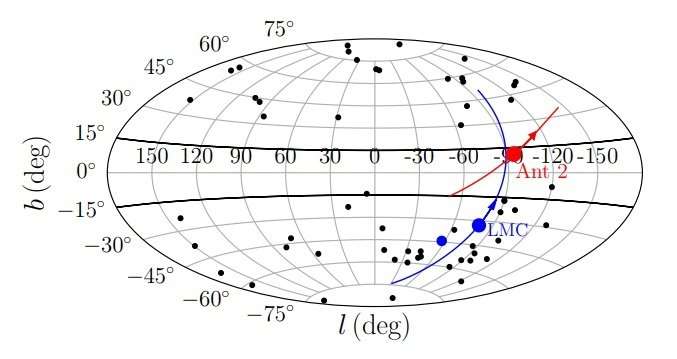November 27, 2018 report
Enormous dwarf satellite galaxy of Milky Way discovered

Using data from ESA's Gaia spacecraft, astronomers have discovered a new Milky Way satellite in the constellation Antlia. The newly found dwarf galaxy, named Antlia 2, is several times larger when compared to other systems of similar luminosity. The finding is detailed in a paper published November 9 on arXiv.org.
The Milky Way is known to be orbited by dozens of smaller, gravitationally bound galaxies. Although the list of identified satellites is relatively long, astronomers believe that some are still undetected.
With the aim of expanding the list of the Milky Way's satellites, a team of astronomers led by Gabriel Torrealba of Academia Sinica in Taipei, Taiwan, has conducted a search for new satellites, especially dwarf galaxies. For their study, the researchers used a combination of astrometry, photometry and variability data provided by Gaia Data Release 2 (DR2).
The search resulted in the finding of an enormous, faint dwarf galaxy orbiting the Milky Way, which has received the designation Antlia 2 (or Ant 2 for short). Its nature was confirmed by spectroscopic observations with the 2dF+AAOmega Spectrograph on the 3.9 m Anglo-Australian Telescope and archival DECam imaging. The astronomers refer to the newly found satellite as "the hidden giant," given that the galaxy turned out to be significantly much larger than other systems in the Local Group with similar luminosity.
"In this paper, we use Gaia Data Release 2 (GDR2, Gaia Collaboration et al. 2018b) to discover and analyze a new dwarf satellite galaxy orbiting the Milky Way. The discovery was made at the Flatiron Gaia Sprint 2018," the researchers wrote in the paper.
Ant 2 is located some 424,000 light years away from the Earth and is estimated to be about 11.2 billion years old. The galaxy has an angular half-light radius of approximately 9,300 light years and a magnitude of –8.5 mag.
The astronomers note that these values make Ant 2 similar in extent to the Large Magellanic Cloud (LMC), but with a luminosity around 4,000 times fainter. They noted that when compared to systems of similar luminosity, Ant 2 is several times larger, while for objects of comparable size, it is about three orders of magnitude fainter.
The researchers also report that Ant 2 is the most diffuse object detected to date, about 100 times more diffuse than the so-called ultra diffuse galaxies (UDGs). Moreover, UDGs with sizes similar to Ant 2 are typically about six mag brighter.
In concluding remarks, the authors of the paper emphasized the unusual properties of Ant 2, which may prove that dwarf galaxy formation can proceed at surface brightness and density levels significantly lower than those so far observed.
"Ant 2 could be the tip of an iceberg—a population of extremely diffuse galactic dwarf galaxies even fainter than the numerous satellites detected in wide-area photometric surveys over the past two decades. Fortunately, Gaia data – as illustrated by this work – may be the key to testing this hypothesis," the researchers concluded.
More information:
G. Torrealba et al. The hidden giant: discovery of an enormous Galactic dwarf satellite in Gaia DR2, arXiv:1811.04082 [astro-ph.GA].
arxiv.org/abs/1811.04082
© 2018 Science X Network


















